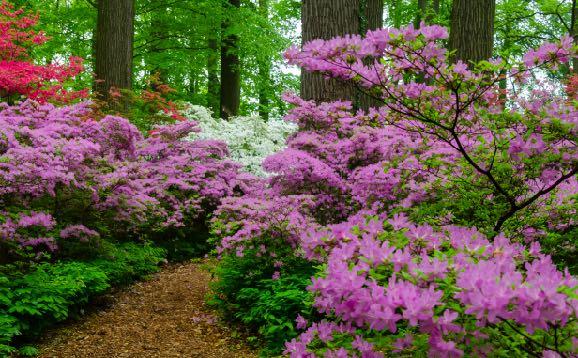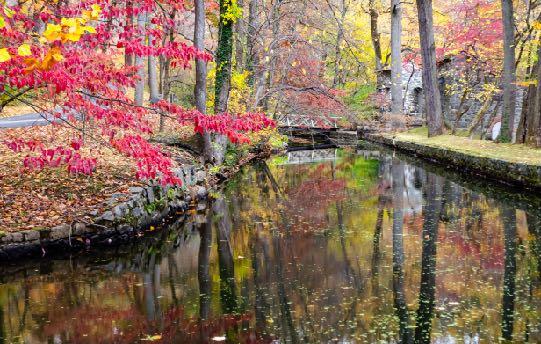
6 minute read
Roadtripping Through the Brandywine Valley Gardens

Advertisement
As a lover of gardens, I consider myself fortunate to be living in the scenic Brandywine Valley of Southeastern Pennsylvania and Northern Delaware. Within a 10-15 minute drive, I have five beautiful and historic gardens that I can enjoy and explore year round. For those wanting to explore the beauty that I call home, a long weekend road trip on the Brandywine Valley National Scenic Byway (Rt 52) will take you to all the best sights where you will discover the legacy left behind by one family: DuPont.

In 1771 a young chemist by the name of E. I du Pont left France and settled on the banks of the Brandywine River in Delaware where he started a gunpowder manufacturing operation. He and his descendants built both a lasting business empire and a lasting legacy of estates and gardens. It is why this region is often referred to as Chateau Country.
The DuPont family history starts at the Hagley Museum, Library and Gardens in Wilmington, DE where the first gunpowder works were established.
Photos (Clockwise from top left): A spring dogwood blooms frame a black powder mill building at Hagley; French gardens at Nemours Estate; French gardens at Nemours Estate; French gardens at Nemours Estate The site includes the restored mills used for making black powder, a worker’s community and the ancestral house and gardens of the du Pont family. A stroll through the 235 acres will take you past outdoor exhibits and demonstrations, including a black powder explosion demonstration.


Just down the road from Hagley is the Nemours Estate. This property is only open from May to November but is well worth a visit if you are in the area during that time. The French inspired mansion and formal gardens will make you wonder if you’ve left the country. Alfred du Pont built the largest French-style gardens in North America and the decorative French-style mansion in 1907 to show his love for his much younger second wife Alicia. Though this is a unique and beautiful location to stroll and explore, it is hardly ever busy. In fact, on my recent visit, I had the gardens all to myself for most of the afternoon.
Continue your scenic byway journey north on Rt. 52 to Winterthur Museum and Gardens for another version of the DuPont story. Here, H F du Pont indulged in his passion for collecting early American furniture and decorative arts which he displayed in a 175 room mansion. As a trained horticulturalist, he also had a personal hand in designing the various elements of the extensive gardens. The gardens are
particularly colorful in spring as a succession of plants, shrubs and trees begin to bloom in early March and continue in waves throughout the naturalistic garden for two months. My favorite tine to stroll here is in early May when acres of white, pink, salmon, red, and lavender azaleas bloom alongside white dogwoods under a canopy of oaks, beech, and tulip poplar trees. Fall can be equally colorful as the woodlands that are part of the 1000 acre preserve change to vibrant shades of yellow and orange.

In contrast, the nearby Mt. Cuba Center puts on a naturalized display of native woodland plants which peak toward the end of April when the dogwood path and the trillium garden are at their best. In the 1960’s Lammot du Pont Copeland and his wife chose to focus their efforts on the conservation of wildflowers and other local native species. Discovering the quiet paths here feels more like a walk in a native forest than a managed garden. Though only open till the end of November, this little gem is also well worth a stop.
Continuing north along Rt. 52 and crossing the border into Pennsylvania will take you to the region’s most famous (and most visited) sight, Longwood Gardens. In 1906 Pierre S DuPont purchased a track of land to protect an arboretum with tress that were over 100 years old. This farm became the centerpiece of his summer residence which he developed into a showpiece for entertaining friends and family. The formal outdoor spaces were inspired by the French and Italian fountain gardens he discovered on his European travels. Pierre added conservatories and an outdoor theater, all of which became the core of one of the


Photos (From top left)): The naturalized gardens at Mt. Cuba Center; The naturalized gardens at Mt. Cuba Center; Azalea woods in full bloom at Winterthur Museum and Gardens; Colorful blooms abound in spring at Winterthur Museum and Gardens; Water lily display at Longwood Gardens


county’s premier horticultural display gardens. There is always something to see or an event to experience at this year round garden. Each season brings its own colors and themes. Whether it is a conservatory full of orchids in the middle of winter, a succession of spring blooming bulbs in the outdoor gardens, a 1000 bloom chrysanthemum in the fall, or millions of twinkling lights for the Christmas display, I always find something beautiful and uplifting when I visit.
You can discover all there is to do in the region on your roadtrip via the Brandywine Valley tourism site.
These five gardens in the Brandywine Valley are but a few of the choices available to you in America’s Garden Capital. With more time, you can continue your road trip and explore all 30 public gardens, arboretums and other historic locations, all within 30 miles of Philadelphia.
Where to Stay in the Brandywine Valley

Start your Brandywine Valley road trip at the historic Hotel DuPont in downtown Wilmington, DE where you can stay in 5 star luxury and style. Located along Rt. 52, the Fairville Inn is a more intimate, though equally historic option.
Where to eat in the Brandywine Valley
These are some of my favorite restaurants in the area that I go to regularly:

Buckley’s Taven for American comfort cuisine
Pizza by Elizabeths for not your typical pizzas all named for a famous Elizabeth
Hearth Kitchen for creative and seasonal entres
Wasabi3 for Asian Fusion and sushi


Photos (Clockwise from top left): A variety of magnolias bloom in spring at Winterthur Museum and Gardens; Lighted fountain display at Longwood Gardens; Vibrant fall colors at Hagley Museum and Gardens; A patchwork of tulips at Longwood Gardens in spring











